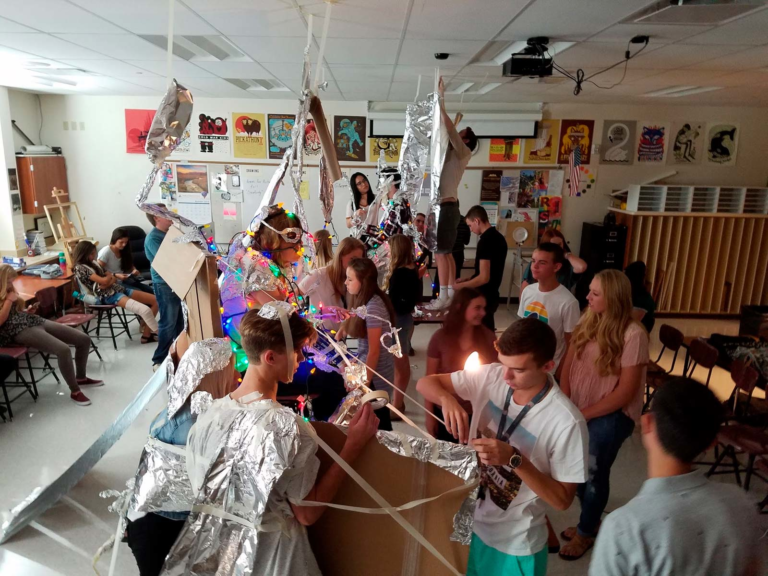High school art educator Jethro Gillespie merges identities as teacher and maker by bringing contemporary art into the classroom
It was the first day of school in Jethro Gillespie’s art classroom at Maple Mountain High School in Spanish Fork, Utah. Rather than review the syllabus, Gillespie welcomed the new students and directed their attention to a “TASK box” on a table in the center of the room. For the entire first class period, students were to alternately deposit slips of paper into the box and take slips out; each with a TASK—literally any action—designed by a student.
Between treks to the box, students would perform the TASK they selected using supplies from the table: colored paper, tape, markers, paint, brushes, cardboard, charcoal, magazines and more. At first, the students glanced uncomfortably around the room, reluctant to participate. Then one brave student stood on a table and began to sing “Mary Had a Little Lamb” loudly and off-key, breaking the ice for his classmates. Soon the room was filled with laughter, conga lines, improvised poems and other activities.

By facilitating a TASK party on the first day of school, Gillespie aimed to set the tone and expectations for his students. Not only did students exchange ideas and materials early on, but the vulnerability inherent in participation initiated trust between students and teacher.
“Engaging with a sense of shared, communal trust is a vital component to a generative art classroom environment,” Gillespie wrote in an article for the Art Education journal, “that, as the semester went on, helped to build a safe and democratic atmosphere where students were more willing to take risks, discuss ideas, embrace ambiguity, as well as develop a more authentic sense of ownership for their art projects.”

Gillespie first learned about TASK through his involvement with Art21 Educators, a professional development initiative and learning community for teachers who want to bring contemporary art, artists and themes into the classroom. Through the Art21 documentary series, Gillespie was introduced to Brooklyn-based artist and TASK creator Oliver Herring, with whom he has collaborated on several projects over the years.
Gillespie, an active artist himself, seeks balance through merging his identities as teacher and maker. Often that means orchestrating socially engaged projects that include his students, like TASK. Other times it means bringing personal projects into the classroom. Recently, Gillespie completed a “Black Tally Mark Quilt,” a work he said emerged from personal ideas about infinity and isolation. The quilt includes approximately 75,000 handstitched tally marks sewn over several months in a variety of locations, including his classroom.

As Gillespie worked on the quilt, several students approached him with questions and he responded based on their level of interest. “It became almost like a socially engaged art as well,” Gillespie said. “I found that it informed my teaching practice to an extent to make myself vulnerable to my students and to connect with them.” From 2009 to 2011 Gillespie earned a master of art education at BYU while teaching full-time.

During that period, Gillespie spent his weekends in class and then tested theories during the week—an experience he said has really impacted his practice. 4For his master’s thesis, Gillespie built a portable art gallery—essentially an eight-foot cube made from plywood and lightweight boards that can be assembled or disassembled in less than 30 minutes—as a way to showcase students’ art and to celebrate their hard work over the year. In addition to creating a cohesive body of work, students are required to organize their show and reception, and to design a promotional poster. This spring marks Gillespie’s ninth year implementing the portable art gallery. Following his master’s program, Gillespie pursued a PhD at Concordia University in Montreal, Canada. After relocating with his family to Canada for one year to complete coursework, Gillespie continued to teach while researching and writing his dissertation, “Rethinking and Remaking a High School Art Foundations Curriculum.” For his work, Gillespie was named runner-up for the Elliott Eisner Doctoral Research Award in Art Education at the 2019 National Art Education Association Convention.

Gillespie continues to cultivate his identity as an artist, both inside and outside the classroom. He is currently working on a series of photos and paintings that involve his students, called “Portraits of Learning.” In 2018, Gillespie’s tally mark quilt was displayed at the Rio Art Gallery in Salt Lake City and was purchased by the state of Utah for their collection.
